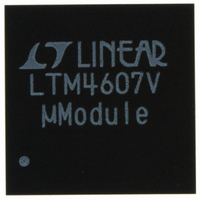LTM4607EV#PBF Linear Technology, LTM4607EV#PBF Datasheet - Page 10

LTM4607EV#PBF
Manufacturer Part Number
LTM4607EV#PBF
Description
IC BUCK/BOOST SYNC ADJ 5A 141LGA
Manufacturer
Linear Technology
Series
µModuler
Type
Point of Load (POL) Non-Isolatedr
Datasheet
1.LTM4607EVPBF.pdf
(26 pages)
Specifications of LTM4607EV#PBF
Design Resources
LTM4607 Spice Model
Output
0.8 ~ 24 V
Number Of Outputs
1
Power (watts)
120W
Mounting Type
Surface Mount
Voltage - Input
4.5 ~ 36 V
Package / Case
141-LGA
1st Output
0.8 ~ 24 VDC @ 5A
Size / Dimension
0.59" L x 0.59" W x 0.11" H (15mm x 15mm x 2.8mm)
Power (watts) - Rated
120W
Operating Temperature
-40°C ~ 85°C
Efficiency
98%
Lead Free Status / RoHS Status
Lead free / RoHS Compliant
3rd Output
-
2nd Output
-
Available stocks
Company
Part Number
Manufacturer
Quantity
Price
LTM4607
APPLICATIONS INFORMATION
oscillator and a phase detector. This allows turning on the
internal top MOSFET for locking to the rising edge of the
external clock. A pulse detection circuit is used to detect
a clock on the PLLIN pin to turn on the phase lock loop.
The input pulse width of the clock has to be at least 400ns,
and 2V in amplitude. The synchronized frequency ranges
from 200kHz to 400kHz, corresponding to a DC voltage
input from 0V to 2.4V at PLLFLTR. During the start up of
the regulator, the phase-lock loop function is disabled.
Low Current Operation
To improve efficiency at low output current operation,
LTM4607 provides three modes for both buck and boost
operations by accepting a logic input on the FCB pin. Table
2 shows the different operation modes.
Table 2. Different Operating Modes
When the FCB pin voltage is lower than 0.8V, the controller
behaves as a continuous, PWM current mode synchronous
switching regulator. When the FCB pin voltage is below
V
Burst Mode operation in boost operation or enters skip-
cycle mode in buck operation. During boost operation,
Burst Mode operation is activated if the load current is
lower than the preset minimum output current level.
10
INTVCC
0V to 0.75V
0.85V to 5V
FCB PIN
>5.3V
– 1V, but greater than 0.85V, the controller enters
Figure 2. Frequency vs PLLFLTR Pin Voltage
450
400
350
300
250
200
150
100
50
0
0
DCM with Constant Freq
Force Continuous Mode
Skip-Cycle Mode
0.5
PLLFLTR PIN VOLTAGE (V)
BUCK
1.0
1.5
2.0
DCM with Constant Freq
Force Continuous Mode
Burst Mode Operation
4607 F02
2.5
BOOST
The MOSFETs will turn on for several cycles, followed by a
variable “sleep” interval depending upon the load current.
During buck operation, skip-cycle mode sets a minimum
positive inductor current level. In this mode, some cycles
will be skipped when the output load current drops below
1% of the maximum designed load in order to maintain
the output voltage.
When the FCB pin voltage is tied to the INTV
controller enters constant frequency discontinuous current
mode (DCM). For boost operation, if the output voltage is
high enough, the controller can enter the continuous current
buck mode for one cycle to discharge inductor current.
In the following cycle, the controller will resume DCM
boost operation. For buck operation, constant frequency
discontinuous current mode is turned on if the preset
minimum negative inductor current level is reached. At
very light loads, this constant frequency operation is not
as efficient as Burst Mode operation or skip-cycle, but
does provide low noise, constant frequency operation.
Input Capacitors
In boost mode, since the input current is continuous, only
minimum input capacitors are required. However, the input
current is discontinuous in buck mode. So the selection
of input capacitor C
input square wave current.
For a buck converter, the switching duty-cycle can be
estimated as:
Without considering the inductor current ripple, the RMS
current of the input capacitor can be estimated as:
In the above equation, η is the estimated efficiency of the
power module. C
aluminum capacitor, OS-CON capacitor or high volume cer-
amic capacitors. Note the capacitor ripple current ratings
are often based on temperature and hours of life. This
makes it advisable to properly derate the input capacitor,
I
D =
CIN(RMS)
V
V
OUT
IN
=
I
OUT(MAX)
IN
η
IN
can be a switcher-rated electrolytic
is driven by the need of filtering the
• D • (1− D)
CC
pin, the
4607fb















